-
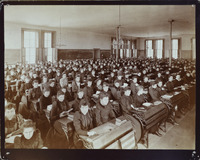 Young Women’s Attendance Room 2nd Floor - Room 50.
Young Women’s Attendance Room 2nd Floor - Room 50. This is another image potentially depicting one of the Friday Conversations, which were voluntary meetings that all female students were invited to attend. During these conversations female faculty members would teach the young women about subjects of practical and professional character. Despite being voluntary, the meetings were well attended as faculty members offered the young women life advice that they would not have the chance to learn in the classroom.
-
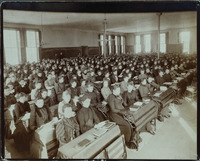 Young Women’s Attendance Room 2nd Floor - Room 50.
Young Women’s Attendance Room 2nd Floor - Room 50. This image depicts female students gathered in an attendance room, perhaps for one of the “Friday Conversations,” that occurred on three Friday afternoons during the school year. These “conversations” would be led by the women faculty members of the Normal, and would last about an hour. The woman standing in the middle at the back of the classroom is likely the head of the History Department, and Preceptress, Julia Anne King. King’s obituary published in the Detroit Free Press in 1919 stated, “Miss. King was unquestionably the best woman educator Michigan has ever had.”
-
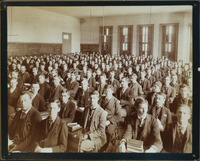 Young Mens Attendance Hall 2nd Floor - Room 37.
Young Mens Attendance Hall 2nd Floor - Room 37. This image depicts male students gathered in an attendance room, and it was possibly taken during one of three yearly “Friday Conversations” led by the Principal or other male staff members. The discussions during the young men’s meetings covered a broad range of topics that were “chiefly determined by passing interests” (Normal Register 1893-94, p.36). These conversations were informal, and followed no schedule or structure.
-
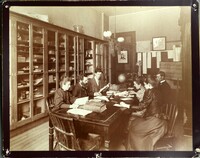 Training School Office of Director Prof. Austin George, T.S. Director.
Training School Office of Director Prof. Austin George, T.S. Director. This image depicts a meeting in the office of the Director of the Training School, Professor Austin George (pictured sitting in the middle on the left side of the table). During the summer of 1863, the same year George graduated from the MSNS, he organized Company E of the 17th Michigan Infantry in the Civil War. After graduating, George moved to Kalamazoo where he worked several positions within the Kalamazoo Public School system, and established a Training School. George returned to the MSNS in 1881, the same year he proposed and started The Normal News, and a year later accepted his role as the Director of the Training School. After significantly expanding and strengthening the Training School curriculum, George left the Normal in 1896 to accept a position as the Superintendent of the Ypsilanti Public Schools.
-
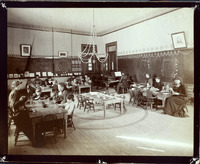 Training School Kindergarten First Floor - Room 24.
Training School Kindergarten First Floor - Room 24. This image depicts a Kindergarten Training School class, which was considered to be a precursor to the “Primary Grades” beginning in first grade. Students as young as four were admitted into the Kindergarten class. The coursework for kindergarteners at the Normal School was rather craft-centric as the register book notes that the children were instructed in over eight different types of crafting from clay-modeling to mat-weaving. Student teachers who wished to work with the Kindergarteners were required to have the ability to sing simple tunes correctly as well as possess “knowledge of pianoforte playing as is required to render the songs and marches of the Kindergarten” in order to graduate.
-
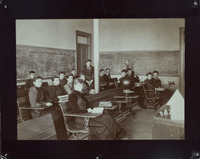 Training School 9th Grade Algebra.
Training School 9th Grade Algebra. This image depicts a 9th grade class, and despite the caption reading “Training School 9th grade”, this grade was not technically part of the training school, but was created to ease the transition between the Training School and Normal School coursework. As such, there was no specific instructor for 9th grade and students were taught by the same instructors as Normal School students. Additionally, ninth grade students were required to choose either the Classical or the English and Scientific Course in order to determine what classes they would be taking, and when. The main difference between the two courses was that Classical students took Latin or German throughout the year, and English and Science students took English classes.
-
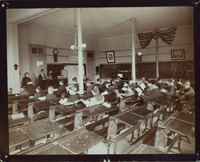 Training school 8th grade 1st floor - room 7
Training school 8th grade 1st floor - room 7 This image depicts an 8th grade Training School class, being led by student teacher K. Maude Cady, who is likely the woman standing behind the podium. Mathematics instruction expanded to cover Algebra in this year, and Geometry lessons were given daily (7th graders only received one lesson a week). U.S. History was also added to the curriculum for eighth graders in the latter half of the year, and the lessons focused on discovery, colonization/settlement, wars, and the overall development of the United States. There was still no organized science curriculum for Training School students in 8th grade, but students were taught about astronomy and meteorology as a part of their “General Lessons” work.
-
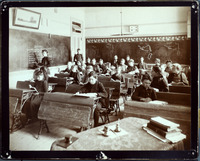 Training School 7th Grade First Floor Room 8-9.
Training School 7th Grade First Floor Room 8-9. This image depicts a class of 7th grade Training School students, many of whom have their faces buried in their books. This was the first grade to move on from solely focusing on arithmetic, as students had Geometry lessons one day per week. Additionally, Seventh grade was also the first year students learned about the world outside of the Americas in Geography class, as the curriculum focused on “Old World studies” which included the study of Europe, Asia, Polynesia, and Africa. There was no history in the curriculum for Training School students until 8th grade.
-
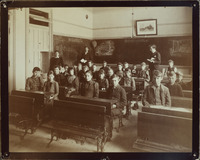 Training School 6th Grade First Floor - Room 10-11
Training School 6th Grade First Floor - Room 10-11 This image depicts a 6th grade Training School class, which was taught by Winnie Robinson, who is likely the adult woman who is standing at the side of the classroom. Grammar lessons were emphasized in this grade, as the most detailed subject in the 6th grade curriculum was Language. Language lessons covered a large array of topics such as sentence structure, syntax, and manuscript work. Additionally, the sixth graders were taught about the dangers of stimulants and narcotics as a part of their General Lessons curriculum.
-
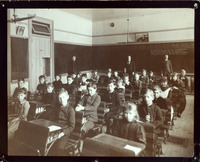 Training School 4th Grade 1st floor Room 15-16.
Training School 4th Grade 1st floor Room 15-16. This image depicts a 4th grade Training School class taught by student teacher Mary Blount, who is likely the woman standing in the back of the classroom. Fourth grade was the last of the “Primary Grades” before moving into the “Grammar Grades” which began at grade 5. Fourth graders in 1892 studied similar subjects to those taught in modern elementary schools, such as reading and writing, spelling, math, art, and music. While there was no science curriculum for 4th grade students, students in this grade learned about personal hygiene and were given oral lessons in physiology.
-
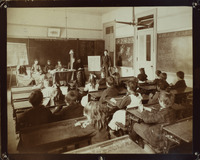 Training School 3rd Grade First Floor - Room 18.
Training School 3rd Grade First Floor - Room 18. This image depicts a math lesson being given to a group of 3rd grade Training School students. The woman standing next to the math equations is likely Harriet Plunkett who taught 3rd grade at the Normal in 1892. Third grade arithmetic consisted of learning numeration to 1,000,000, subtraction, addition, and basic multiplication and division. Students also were also taught about healthy vs. unhealthy foods, and positive eating habits in this grade, as a part of the “General Lessons” curriculum.
-
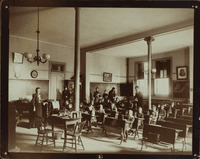 Training School 2nd Grade, 1st Floor - Room 31
Training School 2nd Grade, 1st Floor - Room 31 This image depicts a Second grade Training School class which was taught by Maude Ball, who is likely the woman standing near the piano at the front of the room. The director of the Training School, Austin George, can also be seen in this image standing next to the door. Second graders had a similar curriculum to First graders, and was the last grade to have a “Home Knowledge, etc.” section. “Home Knowledge” introduced students to a variety of subjects that would be explored in greater depth in future grades.
-
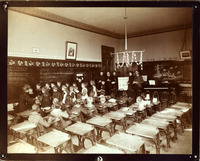 Training School 1st Grade 1st Floor - Room 25.
Training School 1st Grade 1st Floor - Room 25. This image depicts a 1st Grade Training School class led by Lillian Crawford, who is likely the adult woman seated at the front of the lines of students. In the 1st grade, students were taught to read and write and given basic arithmetic lessons where they learned how to count up to 100. The curriculum also included a section called, “Home Knowledge Preparatory to Geography, Botany, Zoology, etc.”, which explains that first graders were exposed to these subjects through observation lessons relating to natural phenomena, plants, and animals. In addition to standard school subjects, 1st graders were also given lessons in morals and manners to teach them proper school etiquette.
-
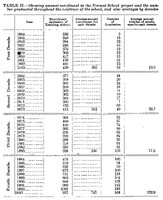 Table II - MSNS enrollment records 1854-1893
Table II - MSNS enrollment records 1854-1893 Unfortunately we have not been able to locate the four charts displayed in Chicago. However, in his 1893 report to the State Board of Education, Principal Sill reproduced this chart “prepared for the Columbian Exposition with laborious care by Professor Austin George.”
-
 Students working in a science laboratory.
Students working in a science laboratory. This image depicts students working in one of the Michigan State Normal School physical science laboratories. Due to the presence of vials, beakers, and other jars containing labeled liquids, the students are likely participating in a standard Chemistry class. Within this class, students gained experience with chemical manipulation and experimentation, while being instructed in the properties of carbon compounds. The Advanced Chemistry course also involved the use of the laboratory, but took “the form of individual practice in Chemical Analysis”.
-
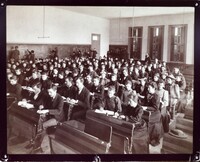 Professional Lecture in Geography.
Professional Lecture in Geography. This image depicts a large group of students attending a Geography lecture, as evidenced by the 9 students who are practicing drawing various continents, as well as the state of Michigan on the chalkboard. Professor Austin George can be seen standing in the back of the lecture room watching over the students. Three additions were made to the Old Main Building, front addition in 1874, rear addition in 1881, and third addition in 1883, to expand the schools available facilities, such as the creation of large lecture rooms to accommodate the Normal’s fast-growing student population. The original lecture rooms on campus only had enough space to house about 60 students.
-
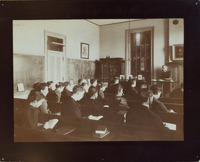 Prof. Barbour English Class.
Prof. Barbour English Class. This image depicts an English class being taught by the head of the English Language and Literature Department, Florus Barbour. Instruction in English Language and Literature focused on three sections: Grammar, Rhetoric, and Literature.
-
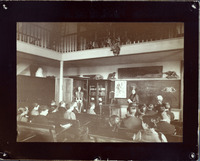 Physiological Lecture Room 3rd Floor - Room 57
Physiological Lecture Room 3rd Floor - Room 57 This image depicts a Physiology Lecture being given by the head of the Natural Sciences (Systematic Botany and Physiology) department, Lucy Osband. One of the main things that this academic department hoped to achieve was instilling a love for scientific truth within Normal students through the help of lessons that focused on utilizing logical reasoning and implementation of the scientific method. Physiology was considered to be an advanced course for senior study, with students having been expected to have learned the basics of the subject in high school. The chalkboard contains evidence that students are being taught about nerves, which indicates that this class is occurring early in the semester when the Physiology curriculum focused on rapid review of the subject with an emphasis on nutrition and the nervous system.
-
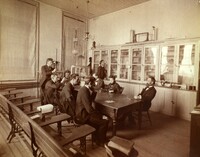 Physics Lab E.A. Strong.
Physics Lab E.A. Strong. This image depicts Physics class being led by the head of the Physical Sciences department, Edwin Atson Strong (seated at the back right corner of the table). Strong’s father was an abolitionist, which allowed Edwin to meet important Black historical figures, including Frederick Douglass, and become familiar with the operations of the Underground Railroad. After working as both a Principal and Superintendent in Grand Rapids, MI, Strong joined the Physical Science faculty at the MSNS in 1885. Strong prioritized his humanitarian efforts over his work in the science department, and worked hard to ensure that his students would live their lives with “profound conviction” (Putnam, p.186).
-
 Physical Training Basement - Room G.
Physical Training Basement - Room G. This image depicts a group of female students participating in the Physiology and Hygiene Course that was developed by Lucy Osband in 1886. Osband taught this course in addition to Natural Science courses, but received no extra pay for doing so. In the basement room in the Old Main, Osband’s program included military marching, pulley weights, and “Swedish Routine Movements,” which involved the use of the dumbbells depicted in the photograph. Physical Culture classes had to be held in the basement due to the fact that the campus gymnasium had burned down in 1873. (Pedersen. Article in photo sheets).
-
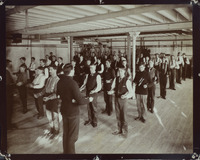 Physical Training Basement - Room G
Physical Training Basement - Room G This image depicts a group of male students participating in a Physical Training session, which was held in the basement of the Old Main building. In the winter of 1892-93, when this image would have been taken, Austin George urged the State Legislature to appropriate funding for a gymnasium building. After Professors Sill, Barbour, and George took several trips to Lansing to pitch their idea to the Legislature, $20,000 was appropriated for the construction of the building which was dedicated on May 18, 1894 (Putnam). The Normal School was the first college in the country to offer teacher training in physical education courses.
-
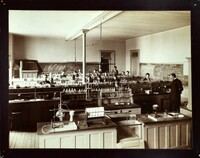 Physical Science Laboratory
Physical Science Laboratory This image depicts students working in one of the school's Physical Science laboratories, likely conducting experiments for one of the Chemistry courses offered by the Normal. As noted by the Normal school register, “in addition to general demonstration work, about one hundred experiments are conducted by the students at their tables.” The chemistry laboratory had thirty stations prepared for student use, stocked with enough equipment for independent experiments.
-
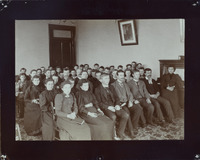 Olympic Society 2nd Floor - Room 38.
Olympic Society 2nd Floor - Room 38. This image depicts a meeting of the Olympic Society, which was one of four literary societies referred to as the “Lyceum Societies.” The Olympic Society was the successor to the Riceonian Literary Society which was started by a group of twelve students in the summer of 1875. The original motto of the Riceonian was “True culture, self-culture,” and the society’s constitution declared that its purpose was to reflect true culture by means of “contact with the thought of the good and the great” (Putnam, 227). The name was changed to the “Olympic” society shortly after 1880 when the Lyceum was reorganized into four literary societies under a single constitution (228).
-
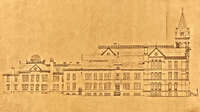 Old Main South Elevation (reconstruction)
Old Main South Elevation (reconstruction) This is a reconstructed drawing of the south elevation of the Old Main building, drawn by Ypsilanti architect E.P. Rorison in the late 19th century. While not confirmed, this drawing was likely displayed in the Michigan State Normal School's exhibit at the 1893 Columbian Exposition.
-
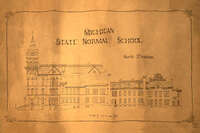 Old Main North Elevation (Reconstruction)
Old Main North Elevation (Reconstruction) This is a reconstructed drawing of the north elevation of the Old Main building, drawn by Ypsilanti architect E.P. Rorison in the late 19th century. While not confirmed, this drawing was likely displayed in the Michigan State Normal School's exhibit at the 1893 Columbian Exposition.
-
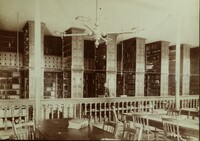 Old Library Reading Room From S.E. Side First Floor- Room 4.
Old Library Reading Room From S.E. Side First Floor- Room 4. This image depicts head librarian Genevieve Walton standing in front of her stacks of books. Walton became the head librarian of the Michigan Normal School in 1892 and is considered to be an important figure within library history. During her 40 years as the head librarian, the library's collection expanded from 12,000 volumes to over 70,000 volumes. She also successfully organized the entire collection using the Dewey decimal system.
-
 Modern Languages 2nd Floor - Room 36.
Modern Languages 2nd Floor - Room 36. This image depicts a Modern Languages class being taught by Annie Patton, who was Dr. Lodeman’s assistant, and the only other German and French language faculty member. There were eight terms for the German course, and six terms for the French course. Students who took all eight terms of the German course were required to teach a German lesson to Training School students to prove their proficiency in the language.
-
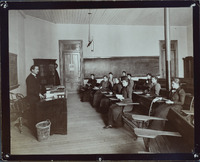 Modern Languages 2nd Floor - Room 35, Dr. Lodeman.
Modern Languages 2nd Floor - Room 35, Dr. Lodeman. This image depicts a Modern Languages course being taught by the head of the German and French Languages Department, Dr. August Lodeman. Lodeman was a German immigrant who came to the US in 1867 and he joined the Michigan State Normal School faculty in 1872 after having obtained American citizenship. Regarding his comprehension of languages, Lodeman was noted to have few equals and was considered to be at the front of the ranks in his profession.
-
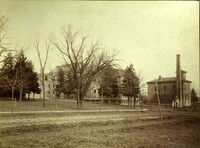 Main building from south, showing Conservatory and Boiler house. Rear of the Normal hall from Cross street.
Main building from south, showing Conservatory and Boiler house. Rear of the Normal hall from Cross street. The three-story Old Main building was constructed in 1852, and was largely paid for by the citizens of Ypsilanti, and other nearby cities (they paid $12,000 and the total cost of the building was ~$20,000). By the time this image was taken in 1893, the Main building had been restored after a fire that had occurred in 1859, and three additions had been completed on the building to accommodate the growing school and student body. The building that would eventually become the Conservatory was first proposed in 1864, but many delays relating to construction and loss of interest in the project delayed its completion until 1870. Originally, the building was used as the Training School, but officially became the Conservatory of music in 1882.
-
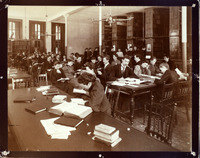 Library First Floor - Room 4.
Library First Floor - Room 4. This image depicts a large group of students studying in the library, which did not yet have its own building when the image was taken in 1893. During the 1892-1893 school year, when beloved librarian Genevieve Walton became head librarian, there were approximately 12,000 volumes in the library’s collection. There was a recognition in the Normal School catalog that the library needed to expand to include individual collections for each academic department. While it is clear there was an impressive collection amassed already, the catalog stated that in regards to their laboratories and library collections, “Much is yet to be desired” (p.83).
-
 Higher Physics First Floor - Room 31
Higher Physics First Floor - Room 31 This image depicts a higher physics classroom full of scientific instruments but void of people. Physics and Chemistry were the two main subjects taught in the Physical Sciences department, and both of these subjects involved a lot of hands-on experimentation in the Normal School’s laboratory rooms. The Normal offered five courses relating to the subject of Physics, all of which prepared students to go on to teach physics at the high school level. The Normal register notes that to be a successful Physics student one had to not only experiment, but also “make a special study of apparatus and manipulation and have some practice in demonstration in the presence of a class” (p.55).
-
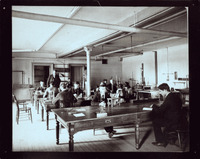 Fred Gorton, Physical Sciences class
Fred Gorton, Physical Sciences class This image depicts one of the Physical Sciences classes being led by the man who is standing at the back of the classroom appears to be Frederick R. Gorton. Gorton graduated from the Michigan State Normal School in 1892 at the age of 21, and immediately joined the Physical Sciences department faculty. Starting his career at the Normal as an instructor, Gorton eventually went on to receive a Ph.D. from the University of Berlin, Germany, and then worked as a professor at the Normal until his retirement in 1941.
-
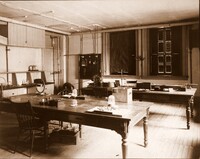 Empty Physics Laboratory
Empty Physics Laboratory This image depicts an empty Physics laboratory, with apparatuses that students used to learn about electricity. According to the 1892-93 Normal Register, Electricity and Light was taught during the second term of the Elementary Physics course. In this course, the purchase, testing, care, and effective use of apparatus was given considerable attention. Hands-on experimentation was prioritized in the physics courses, and all students were expected to demonstrate their knowledge of apparatus manipulation in the presence of a class.
-
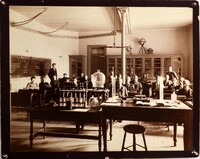 Elementary Physics First Floor - Room 30, Prof. Gorton
Elementary Physics First Floor - Room 30, Prof. Gorton This image depicts an Elementary Physics class being taught by Professor Fred Gorton. The Physical Sciences occupied the majority of Gorton’s free time, which is evident in the fact that, in addition to serving as a part of the Physical Sciences Department, Gorton was a member of the Sociétéde Physique (Physical Society) and the American Academy for the Advancement of Science (Aurora, 1912, p. 49). Fred remained a part of the Michigan State Normal College’s faculty for 50 years, retiring only a few years before his passing.
-
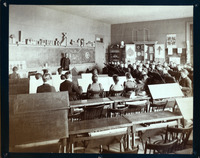 Drawing 2nd Floor - Room 57.
Drawing 2nd Floor - Room 57. This image depicts the same drawing class depicted in 4-4 from a different perspective. The class in the photograph is likely an elementary level drawing class as there was a focus on geometrical shapes. The elementary class was a modified version of the Drawing curriculum given to Training School students, and was designed to prepare students to teach basic art lessons at the Elementary level. Subsequent Drawing courses built upon the principles taught in the elementary coursework, and senior students would teach lessons to the Training School students under the supervision of the department head for practice.
-
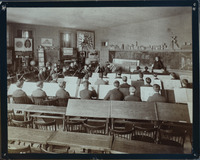 Drawing 2nd Floor - Room 51.
Drawing 2nd Floor - Room 51. This image depicts a Drawing class, likely being taught by Charles T. McFarlane before he officially joined the Drawing department. The sole faculty member of the Drawing department listed in the 1892-93 register, John Goodison, passed away sometime around October 1892, a few months before this picture would have been taken. Goodison had been a part of the Normal faculty since 1861, and was highly regarded by both staff and students alike. He was described as being patient no matter the circumstance, and he always had words of encouragement for his students regardless of their talent level.
-
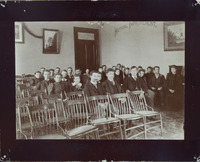 Crescent Society First Floor - Room 5.
Crescent Society First Floor - Room 5. This image depicts a meeting of the Crescent Society, which was the last club added to the Lyceum Societies in the spring of 1882. A part of the society's motto,“Mutual Improvement, Mutual Enjoyment,” can be seen on the wall in the photograph. This motto was chosen because Crescent Society members believed that genuine improvement and enjoyment is not found alone, but with companions. With this in mind, the purpose of the Crescent Society was for members to practice expressing their thoughts in a group setting rather than solely focusing on independent thought and study. - (Aurora 1893, p.77).
-
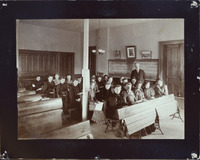 Conservatory Recitation & Lecture Room First Floor.
Conservatory Recitation & Lecture Room First Floor. This image depicts a class being taught in the Conservatory Recitation and Lecture room by the Director of the Conservatory Frederic Pease. Music was a required course for graduation. While the Music course offered by the Normal was free, students who wished to receive advanced voice or instrument training had to pay to take courses in the Conservatory. Students who wanted to join the Normal Choir were required to have passed the music course, in which they were taught how to read music and cultivate their voices.
-
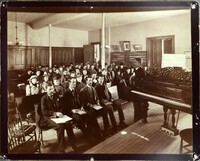 Conservatory - Recitation & Lecture Room First Floor - Room 61.
Conservatory - Recitation & Lecture Room First Floor - Room 61. This image depicts a class being taught in the Conservatory under the direction of instructor Oscar Gareissen. The Conservatory provided a regular four-year course leading to a teaching certificate, and also offered advanced instruction in either vocal or instrumental music. The three instruments available for students to choose from were the piano, violin, and organ. Students who proved to be competent with their instruments were given opportunities to accompany the vocal students and play their own recitals.
-
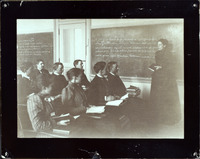 Classical Languages 2nd Floor Room 45.
Classical Languages 2nd Floor Room 45. This image depicts a Latin language class being taught by Helen B. Muir, who acted as Benjamin D’Ooge’s assistant in the Ancient Languages Department. Due to the fact that “Caesar” can be seen on the chalkboard, it is likely that this was a second year Latin class as the curriculum focused heavily on Caesar’s commentaries. According to the 1892-93 Normal register, “the reading of some good biography of Caesar” was also required. Four years of Latin lessons were offered to all Normal students, but advanced courses were only offered to students pursuing the advanced courses leading to the degree of Bachelor of Pedagogics.
-
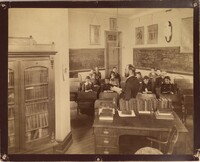 Classical Languages 2nd Floor - Room 34, D’Ooge.
Classical Languages 2nd Floor - Room 34, D’Ooge. This image depicts a Classical Languages class being taught by Benjamin D’Ooge, the head of the Latin and Greek Languages Department. In the second row, to the far left, a young Black woman can be seen looking directly into the camera. While the identity of the woman is not confirmed, she may be the granddaughter of H.P. Jacobs, a man who escaped from slavery and worked as a janitor at the Normal school before returning to the newly-free South and becoming one of the most influential Black Baptist preachers of the late 19th century. Jacobs’ children were the first Black students to attend the Michigan State Normal School, and when this photo was taken Jacobs’ granddaughter, Allie Louise DeHazen, was a student at the school.
-
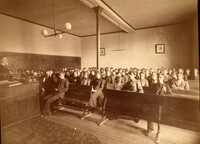 Class Led by Daniel Putnam
Class Led by Daniel Putnam This image depicts a class being led by the head of the “Mental and Moral Sciences” department and vice principal, Daniel Putnam. Putnam served as a professor of Pedagogy at the MSNS between 1868 and 1906 and was the acting Principal of the Normal 1881-83 and 1885-86. Putnam was also the President of the Michigan State Teachers Association, President and Treasurer of the Baptist Convention of Michigan, and served as the Mayor of Ypsilanti between 1889-91. Putnam is also responsible for writing the first comprehensive history of EMU, A History Of The Michigan State Normal School (Now Normal College) at Ypsilanti, Michigan 1849-1899 (published 1899).
-
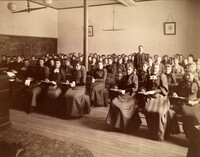 Class in Psychology First Floor - Room 3.
Class in Psychology First Floor - Room 3. This image depicts a psychology or “Mental and Moral Sciences” class being led by the man seen standing in the photograph, Perry Trowbridge. Psychology courses were required for all students, and were considered to be a part of the Pedagogy curriculum. The two courses were Elements of Psychology, which explored the basic principles of the field, and General Application of Psychology, which taught students how to apply basic psychological principles to the art of teaching. Students who wanted to receive their Bachelor of Pedagogics were also required to take an Advanced Psychology course, which also included lessons focused on philosophy.
-
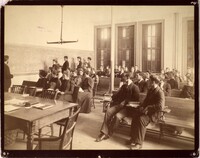 Class in Mathematics First Floor - Room 26.
Class in Mathematics First Floor - Room 26. This image depicts a Mathematics class being taught by the head of the Math Department, David Eugene Smith. Dr. Smith originally joined the Normal faculty during the 1890-91 school year and would remain in his position until 1898, when he moved back to his home state of New York to be the principal of the Normal School in Brockport. During his seven years at the MSNS, Smith co-authored and published four textbooks relating to mathematics. Today, Smith is considered to be one of the founders of the field of mathematics education, and he was able to make students see the true beauty and depth of mathematics.
-
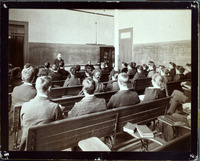 Class in Mathematics First Floor - room 26 Prof. Sill Seated.
Class in Mathematics First Floor - room 26 Prof. Sill Seated. This image depicts a math class being taught by the head of the Mathematics department, David E. Smith, with Principal Sill (the man seated) observing. The academic work in the Mathematics course included all the standard math courses one would have generally taken in high school, with more advanced courses such as Trigonometry, Calculus, Analytical Geometry, etc. generally being offered as electives. Students entering the Normal were only required to have completed Arithmetic and have some familiarity with simple algebraic equations. The reason for the Normal heavily focusing on arithmetic and elementary-level mathematics was due to the fact that the school existed to teach future educators who would likely end up teaching in the elementary - high school levels.
-
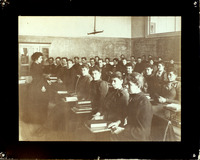 Class in Mathematics First Floor - Room 22.
Class in Mathematics First Floor - Room 22. This image depicts a class being led by Mathematics instructor Emma Ackerman, who joined the Normal faculty in the 1892-93 school year. In addition to being an instructor, Miss. Ackerman acted as the assistant to the head of the Mathematics department, David Smith between 1892-98. She left the Normal in 1898 after receiving her Bachelor's degree in Pedagogics.
-
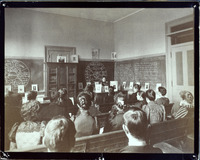 Class in Literature Second Floor Room - 41, Abigail Pearce
Class in Literature Second Floor Room - 41, Abigail Pearce This image depicts another angle of Abbie Pearce’s Literature class (see 4-8). Abbie Pearce was one of 3 founding advisors of the Alpha Sigma Tau sorority that still has chapters at EMU and around the US today. Pearce, alongside Ada Norton (in the Mathematics department), came up with the cultural and ritual aspects of the sorority.
-
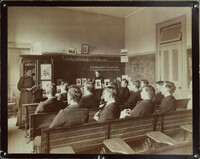 Class in Literature Second Floor - Room 42.
Class in Literature Second Floor - Room 42. This image depicts a Literature class being led by the woman standing at the front of the room, who is likely Lois McMahon. On the chalkboard, there is a quote by British essayist Thomas Carlyle that reads, “Literature is the thought of thinking souls.” The full literature course extends through four semesters, each semester being devoted to one subject. The four subjects that are covered in the Literature course are: English Literature, American Literature, Old and Middle English, and Masterpiece Study.
-
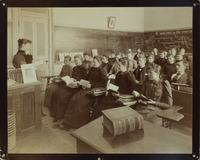 Class in Literature Second Floor - Room 42
Class in Literature Second Floor - Room 42 This image depicts a Literature class. There is a prominent quote on the chalkboard that reads, “Truth is the highest thing a man may keep.” Literature played a prominent role in the lives of many students at the Normal, as the four largest clubs at the Normal were literary societies. Additionally the English Language and Literature Department was one of the largest departments at the Normal in 1893 which, along with the Mathematics Department, had four staff members (some departments only had one staff member at the time).
-
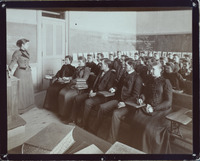 Class in Literature Second Floor - Room 31.
Class in Literature Second Floor - Room 31. This image depicts a literature class being taught by Abbie Pearce. On the chalkboard lining the side wall is the quote: "Genius is universal, genius is an immense capacity for taking pains" which was a common proverbial saying in the 19th century, and may have originated from English reformer Jane Hopkins. There is another quote left reading: "A good book is the spiritual life blood of a master spirit,” by English poet John Milton. Due to both quotations having a connection to English individuals, this image may depict the last term in the Literary Course that focused on the study of English masterpieces.
-
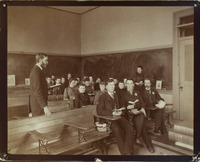 Class in Literature 2nd Floor - Room 44
Class in Literature 2nd Floor - Room 44 This image depicts a Literature class being taught by the head of the English Language and Literature department, Florus Barbour. When Barbour began his teaching career, he viewed teaching only as a stepping stone to his desired career path of preaching from behind the pulpit. Eventually, however, Barbour grew to understand the importance of public school work and the teaching profession, and grew deeply loyal to the Michigan State Normal School. The English Department head never fully departed from his theological interests, as he impressed upon his students the “value and importance of moral and religious character in teachers” (Putnam).
-
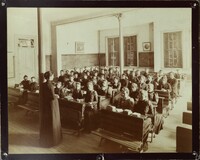 Class In History Second Floor - Room 49.
Class In History Second Floor - Room 49. This image depicts a history class being taught by Florence Shultes, an instructor in the History and Civil Government department. One of the conditions of admission into the Normal school was that students were required to have knowledge of the significant elements of American history and be able to express critical thinking skills. This is made evident in the 1893-94 Normal register when it states, “History furnishes material for judgements, and unless the pupil has learned to see the relations between the facts, to compare, to judge, that is to think, to use the facts, he is not ready for any such study as Political History.” (p.56)
-
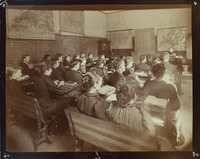 Class in History Second Floor - Room 48, Mary Putnam
Class in History Second Floor - Room 48, Mary Putnam This image depicts a History class being taught by Mary Putnam, who is sitting behind the desk at the head of the room. The History curriculum at the Normal school focused heavily on the history of the Western world, with American and English history being prioritized. The Normal’s General History coursework focused heavily on Greek and Roman history, and the extent to which the history of non-Western cultures were covered is not discussed in the course description. Much of the discussion relating to non-Western societies appears to have been relegated to the Geography department.
-
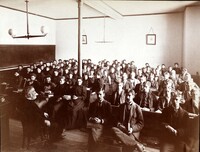 Class in History of Education First Floor - Room 2.
Class in History of Education First Floor - Room 2. This image depicts a class called The History of Education being taught by Daniel Putnam, who taught the Theory of Art and Teaching courses in addition to psychology courses. This class only took half of one semester to complete and focused on the history of schools, school systems, and education in general. To help students understand how the field of education had progressed, Putnam taught about great educational leaders of both the past and the present.
-
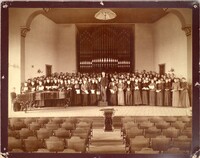 Choir standing behind Director Frederic Pease
Choir standing behind Director Frederic Pease This image depicts the Normal Choir standing behind Director, Frederic Pease, on the stage of the auditorium on the third floor of Old Main. The Normal chorus generally consisted of about one hundred and fifty voices, who would meet daily for one-and-a-half-hour rehearsals. The work in The Normal Choir consisted of preparing music to perform at public school exercises and concerts that would be given throughout the year. The choir also assisted in leading worship during the daily Chapel Exercises that took place in the Normal Hall every morning at 8:20.
-
 Biological Lecture Room 3rd floor - Room 58.
Biological Lecture Room 3rd floor - Room 58. This image depicts a lecture being given by William H. Sherzer, who taught courses relating to Structural Botany, Zoology, and Geology. While this room is identified as the “biological lecture room”, the only course with “biology” or “biological” in its name was Biological Technics, a laboratory course that taught students how to properly handle animal and plant specimens “for purposes of study and illustration.” This class also taught students how to skin and mount birds and small mammals, as well as, clean and articulate skeletons, evidence of which can be seen in and on top of the cabinets in the back of the room. In the late 19th century, the Normal had a collection of over 1000 animal specimens and 2000+ insect specimens.
-
 Biological Laboratory 3rd Floor - Room 59.
Biological Laboratory 3rd Floor - Room 59. This image depicts students working in the biological laboratory taken during the winter of the 1892-93 school year. The Normal had 66 microscopes in total (36 compounds and 30 dissecting), many of which can be seen being used by students in the photograph. To prepare microscopic specimens for use in the dissecting microscopes, the lab was stocked with a single microtome, a precision cutting instrument that produces extremely thin slices of various biological materials. The Normal had a Thoma and Minot brand microtome (invented in 1886), that was the most advanced microtome available on the market in the late 19th century.
-
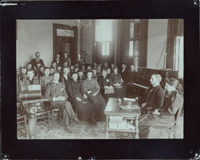 Athenaeum Society First Floor -Room 6.
Athenaeum Society First Floor -Room 6. This image depicts another of the clubs that was organized under the Lyceum constitution, the Athenaeum Society. All four of the literary societies had a limit of 60 members, and membership was usually full. According to the 1893 Aurora, the Atheneum was “the most conveniently and finely furnished of the societies, and out of debt.” This student organization prided itself on its weekly programs. In 1893, when this photograph was taken, five out of the eight Normal students who were given commencement honors were members of the Atheneum Society (pg.81).
-
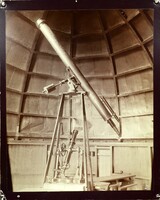 Alvan Clark refractor telescope located in the third floor Observatory - Room 59.
Alvan Clark refractor telescope located in the third floor Observatory - Room 59. This image depicts the Alvan Clark refractor telescope (large), and the Brandis transit telescope (small). The Alvan Clark 4'' refractor telescope, purchased in 1872 for about $300; Brandis transit telescope purchased in 1876 for $680.00 (small scope sitting under larger telescope). Both of these telescopes were placed in the observatory dome after construction was completed in 1881. In 1893 a tornado carried the observatory dome twenty-five feet, and while both of the telescopes were able to be repaired after the disaster the Brandis was unfortunately lost in the Sherzer Hall fire of 1989. About half of Sherzer was gutted during the fire, marking it one of the most devastating events in our university’s history. The Alvan Clark telescope is currently housed in the Sherzer Observatory.
-
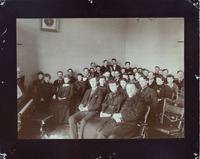 Adelphic Society Second Floor - Room 39.
Adelphic Society Second Floor - Room 39. The image depicts a meeting of the Adelphic Society, another of the Lyceum Societies created during the reorganization in 1881. The motto of this society was “Vita sine litteris mors est” which roughly translates to “Life without literature is death.” The purpose of the Adelphic Society was to combine culture with recreation. As such, the Adelphics meeting room was, in 1891, furnished with a piano as well as other necessities to be used for entertainment purposes (musicals and plays).
 Young Women’s Attendance Room 2nd Floor - Room 50. This is another image potentially depicting one of the Friday Conversations, which were voluntary meetings that all female students were invited to attend. During these conversations female faculty members would teach the young women about subjects of practical and professional character. Despite being voluntary, the meetings were well attended as faculty members offered the young women life advice that they would not have the chance to learn in the classroom.
Young Women’s Attendance Room 2nd Floor - Room 50. This is another image potentially depicting one of the Friday Conversations, which were voluntary meetings that all female students were invited to attend. During these conversations female faculty members would teach the young women about subjects of practical and professional character. Despite being voluntary, the meetings were well attended as faculty members offered the young women life advice that they would not have the chance to learn in the classroom. Young Women’s Attendance Room 2nd Floor - Room 50. This image depicts female students gathered in an attendance room, perhaps for one of the “Friday Conversations,” that occurred on three Friday afternoons during the school year. These “conversations” would be led by the women faculty members of the Normal, and would last about an hour. The woman standing in the middle at the back of the classroom is likely the head of the History Department, and Preceptress, Julia Anne King. King’s obituary published in the Detroit Free Press in 1919 stated, “Miss. King was unquestionably the best woman educator Michigan has ever had.”
Young Women’s Attendance Room 2nd Floor - Room 50. This image depicts female students gathered in an attendance room, perhaps for one of the “Friday Conversations,” that occurred on three Friday afternoons during the school year. These “conversations” would be led by the women faculty members of the Normal, and would last about an hour. The woman standing in the middle at the back of the classroom is likely the head of the History Department, and Preceptress, Julia Anne King. King’s obituary published in the Detroit Free Press in 1919 stated, “Miss. King was unquestionably the best woman educator Michigan has ever had.” Young Mens Attendance Hall 2nd Floor - Room 37. This image depicts male students gathered in an attendance room, and it was possibly taken during one of three yearly “Friday Conversations” led by the Principal or other male staff members. The discussions during the young men’s meetings covered a broad range of topics that were “chiefly determined by passing interests” (Normal Register 1893-94, p.36). These conversations were informal, and followed no schedule or structure.
Young Mens Attendance Hall 2nd Floor - Room 37. This image depicts male students gathered in an attendance room, and it was possibly taken during one of three yearly “Friday Conversations” led by the Principal or other male staff members. The discussions during the young men’s meetings covered a broad range of topics that were “chiefly determined by passing interests” (Normal Register 1893-94, p.36). These conversations were informal, and followed no schedule or structure. Training School Office of Director Prof. Austin George, T.S. Director. This image depicts a meeting in the office of the Director of the Training School, Professor Austin George (pictured sitting in the middle on the left side of the table). During the summer of 1863, the same year George graduated from the MSNS, he organized Company E of the 17th Michigan Infantry in the Civil War. After graduating, George moved to Kalamazoo where he worked several positions within the Kalamazoo Public School system, and established a Training School. George returned to the MSNS in 1881, the same year he proposed and started The Normal News, and a year later accepted his role as the Director of the Training School. After significantly expanding and strengthening the Training School curriculum, George left the Normal in 1896 to accept a position as the Superintendent of the Ypsilanti Public Schools.
Training School Office of Director Prof. Austin George, T.S. Director. This image depicts a meeting in the office of the Director of the Training School, Professor Austin George (pictured sitting in the middle on the left side of the table). During the summer of 1863, the same year George graduated from the MSNS, he organized Company E of the 17th Michigan Infantry in the Civil War. After graduating, George moved to Kalamazoo where he worked several positions within the Kalamazoo Public School system, and established a Training School. George returned to the MSNS in 1881, the same year he proposed and started The Normal News, and a year later accepted his role as the Director of the Training School. After significantly expanding and strengthening the Training School curriculum, George left the Normal in 1896 to accept a position as the Superintendent of the Ypsilanti Public Schools. Training School Kindergarten First Floor - Room 24. This image depicts a Kindergarten Training School class, which was considered to be a precursor to the “Primary Grades” beginning in first grade. Students as young as four were admitted into the Kindergarten class. The coursework for kindergarteners at the Normal School was rather craft-centric as the register book notes that the children were instructed in over eight different types of crafting from clay-modeling to mat-weaving. Student teachers who wished to work with the Kindergarteners were required to have the ability to sing simple tunes correctly as well as possess “knowledge of pianoforte playing as is required to render the songs and marches of the Kindergarten” in order to graduate.
Training School Kindergarten First Floor - Room 24. This image depicts a Kindergarten Training School class, which was considered to be a precursor to the “Primary Grades” beginning in first grade. Students as young as four were admitted into the Kindergarten class. The coursework for kindergarteners at the Normal School was rather craft-centric as the register book notes that the children were instructed in over eight different types of crafting from clay-modeling to mat-weaving. Student teachers who wished to work with the Kindergarteners were required to have the ability to sing simple tunes correctly as well as possess “knowledge of pianoforte playing as is required to render the songs and marches of the Kindergarten” in order to graduate. Training School 9th Grade Algebra. This image depicts a 9th grade class, and despite the caption reading “Training School 9th grade”, this grade was not technically part of the training school, but was created to ease the transition between the Training School and Normal School coursework. As such, there was no specific instructor for 9th grade and students were taught by the same instructors as Normal School students. Additionally, ninth grade students were required to choose either the Classical or the English and Scientific Course in order to determine what classes they would be taking, and when. The main difference between the two courses was that Classical students took Latin or German throughout the year, and English and Science students took English classes.
Training School 9th Grade Algebra. This image depicts a 9th grade class, and despite the caption reading “Training School 9th grade”, this grade was not technically part of the training school, but was created to ease the transition between the Training School and Normal School coursework. As such, there was no specific instructor for 9th grade and students were taught by the same instructors as Normal School students. Additionally, ninth grade students were required to choose either the Classical or the English and Scientific Course in order to determine what classes they would be taking, and when. The main difference between the two courses was that Classical students took Latin or German throughout the year, and English and Science students took English classes. Training school 8th grade 1st floor - room 7 This image depicts an 8th grade Training School class, being led by student teacher K. Maude Cady, who is likely the woman standing behind the podium. Mathematics instruction expanded to cover Algebra in this year, and Geometry lessons were given daily (7th graders only received one lesson a week). U.S. History was also added to the curriculum for eighth graders in the latter half of the year, and the lessons focused on discovery, colonization/settlement, wars, and the overall development of the United States. There was still no organized science curriculum for Training School students in 8th grade, but students were taught about astronomy and meteorology as a part of their “General Lessons” work.
Training school 8th grade 1st floor - room 7 This image depicts an 8th grade Training School class, being led by student teacher K. Maude Cady, who is likely the woman standing behind the podium. Mathematics instruction expanded to cover Algebra in this year, and Geometry lessons were given daily (7th graders only received one lesson a week). U.S. History was also added to the curriculum for eighth graders in the latter half of the year, and the lessons focused on discovery, colonization/settlement, wars, and the overall development of the United States. There was still no organized science curriculum for Training School students in 8th grade, but students were taught about astronomy and meteorology as a part of their “General Lessons” work. Training School 7th Grade First Floor Room 8-9. This image depicts a class of 7th grade Training School students, many of whom have their faces buried in their books. This was the first grade to move on from solely focusing on arithmetic, as students had Geometry lessons one day per week. Additionally, Seventh grade was also the first year students learned about the world outside of the Americas in Geography class, as the curriculum focused on “Old World studies” which included the study of Europe, Asia, Polynesia, and Africa. There was no history in the curriculum for Training School students until 8th grade.
Training School 7th Grade First Floor Room 8-9. This image depicts a class of 7th grade Training School students, many of whom have their faces buried in their books. This was the first grade to move on from solely focusing on arithmetic, as students had Geometry lessons one day per week. Additionally, Seventh grade was also the first year students learned about the world outside of the Americas in Geography class, as the curriculum focused on “Old World studies” which included the study of Europe, Asia, Polynesia, and Africa. There was no history in the curriculum for Training School students until 8th grade. Training School 6th Grade First Floor - Room 10-11 This image depicts a 6th grade Training School class, which was taught by Winnie Robinson, who is likely the adult woman who is standing at the side of the classroom. Grammar lessons were emphasized in this grade, as the most detailed subject in the 6th grade curriculum was Language. Language lessons covered a large array of topics such as sentence structure, syntax, and manuscript work. Additionally, the sixth graders were taught about the dangers of stimulants and narcotics as a part of their General Lessons curriculum.
Training School 6th Grade First Floor - Room 10-11 This image depicts a 6th grade Training School class, which was taught by Winnie Robinson, who is likely the adult woman who is standing at the side of the classroom. Grammar lessons were emphasized in this grade, as the most detailed subject in the 6th grade curriculum was Language. Language lessons covered a large array of topics such as sentence structure, syntax, and manuscript work. Additionally, the sixth graders were taught about the dangers of stimulants and narcotics as a part of their General Lessons curriculum. Training School 4th Grade 1st floor Room 15-16. This image depicts a 4th grade Training School class taught by student teacher Mary Blount, who is likely the woman standing in the back of the classroom. Fourth grade was the last of the “Primary Grades” before moving into the “Grammar Grades” which began at grade 5. Fourth graders in 1892 studied similar subjects to those taught in modern elementary schools, such as reading and writing, spelling, math, art, and music. While there was no science curriculum for 4th grade students, students in this grade learned about personal hygiene and were given oral lessons in physiology.
Training School 4th Grade 1st floor Room 15-16. This image depicts a 4th grade Training School class taught by student teacher Mary Blount, who is likely the woman standing in the back of the classroom. Fourth grade was the last of the “Primary Grades” before moving into the “Grammar Grades” which began at grade 5. Fourth graders in 1892 studied similar subjects to those taught in modern elementary schools, such as reading and writing, spelling, math, art, and music. While there was no science curriculum for 4th grade students, students in this grade learned about personal hygiene and were given oral lessons in physiology. Training School 3rd Grade First Floor - Room 18. This image depicts a math lesson being given to a group of 3rd grade Training School students. The woman standing next to the math equations is likely Harriet Plunkett who taught 3rd grade at the Normal in 1892. Third grade arithmetic consisted of learning numeration to 1,000,000, subtraction, addition, and basic multiplication and division. Students also were also taught about healthy vs. unhealthy foods, and positive eating habits in this grade, as a part of the “General Lessons” curriculum.
Training School 3rd Grade First Floor - Room 18. This image depicts a math lesson being given to a group of 3rd grade Training School students. The woman standing next to the math equations is likely Harriet Plunkett who taught 3rd grade at the Normal in 1892. Third grade arithmetic consisted of learning numeration to 1,000,000, subtraction, addition, and basic multiplication and division. Students also were also taught about healthy vs. unhealthy foods, and positive eating habits in this grade, as a part of the “General Lessons” curriculum. Training School 2nd Grade, 1st Floor - Room 31 This image depicts a Second grade Training School class which was taught by Maude Ball, who is likely the woman standing near the piano at the front of the room. The director of the Training School, Austin George, can also be seen in this image standing next to the door. Second graders had a similar curriculum to First graders, and was the last grade to have a “Home Knowledge, etc.” section. “Home Knowledge” introduced students to a variety of subjects that would be explored in greater depth in future grades.
Training School 2nd Grade, 1st Floor - Room 31 This image depicts a Second grade Training School class which was taught by Maude Ball, who is likely the woman standing near the piano at the front of the room. The director of the Training School, Austin George, can also be seen in this image standing next to the door. Second graders had a similar curriculum to First graders, and was the last grade to have a “Home Knowledge, etc.” section. “Home Knowledge” introduced students to a variety of subjects that would be explored in greater depth in future grades. Training School 1st Grade 1st Floor - Room 25. This image depicts a 1st Grade Training School class led by Lillian Crawford, who is likely the adult woman seated at the front of the lines of students. In the 1st grade, students were taught to read and write and given basic arithmetic lessons where they learned how to count up to 100. The curriculum also included a section called, “Home Knowledge Preparatory to Geography, Botany, Zoology, etc.”, which explains that first graders were exposed to these subjects through observation lessons relating to natural phenomena, plants, and animals. In addition to standard school subjects, 1st graders were also given lessons in morals and manners to teach them proper school etiquette.
Training School 1st Grade 1st Floor - Room 25. This image depicts a 1st Grade Training School class led by Lillian Crawford, who is likely the adult woman seated at the front of the lines of students. In the 1st grade, students were taught to read and write and given basic arithmetic lessons where they learned how to count up to 100. The curriculum also included a section called, “Home Knowledge Preparatory to Geography, Botany, Zoology, etc.”, which explains that first graders were exposed to these subjects through observation lessons relating to natural phenomena, plants, and animals. In addition to standard school subjects, 1st graders were also given lessons in morals and manners to teach them proper school etiquette. Table II - MSNS enrollment records 1854-1893 Unfortunately we have not been able to locate the four charts displayed in Chicago. However, in his 1893 report to the State Board of Education, Principal Sill reproduced this chart “prepared for the Columbian Exposition with laborious care by Professor Austin George.”
Table II - MSNS enrollment records 1854-1893 Unfortunately we have not been able to locate the four charts displayed in Chicago. However, in his 1893 report to the State Board of Education, Principal Sill reproduced this chart “prepared for the Columbian Exposition with laborious care by Professor Austin George.” Students working in a science laboratory. This image depicts students working in one of the Michigan State Normal School physical science laboratories. Due to the presence of vials, beakers, and other jars containing labeled liquids, the students are likely participating in a standard Chemistry class. Within this class, students gained experience with chemical manipulation and experimentation, while being instructed in the properties of carbon compounds. The Advanced Chemistry course also involved the use of the laboratory, but took “the form of individual practice in Chemical Analysis”.
Students working in a science laboratory. This image depicts students working in one of the Michigan State Normal School physical science laboratories. Due to the presence of vials, beakers, and other jars containing labeled liquids, the students are likely participating in a standard Chemistry class. Within this class, students gained experience with chemical manipulation and experimentation, while being instructed in the properties of carbon compounds. The Advanced Chemistry course also involved the use of the laboratory, but took “the form of individual practice in Chemical Analysis”. Professional Lecture in Geography. This image depicts a large group of students attending a Geography lecture, as evidenced by the 9 students who are practicing drawing various continents, as well as the state of Michigan on the chalkboard. Professor Austin George can be seen standing in the back of the lecture room watching over the students. Three additions were made to the Old Main Building, front addition in 1874, rear addition in 1881, and third addition in 1883, to expand the schools available facilities, such as the creation of large lecture rooms to accommodate the Normal’s fast-growing student population. The original lecture rooms on campus only had enough space to house about 60 students.
Professional Lecture in Geography. This image depicts a large group of students attending a Geography lecture, as evidenced by the 9 students who are practicing drawing various continents, as well as the state of Michigan on the chalkboard. Professor Austin George can be seen standing in the back of the lecture room watching over the students. Three additions were made to the Old Main Building, front addition in 1874, rear addition in 1881, and third addition in 1883, to expand the schools available facilities, such as the creation of large lecture rooms to accommodate the Normal’s fast-growing student population. The original lecture rooms on campus only had enough space to house about 60 students. Prof. Barbour English Class. This image depicts an English class being taught by the head of the English Language and Literature Department, Florus Barbour. Instruction in English Language and Literature focused on three sections: Grammar, Rhetoric, and Literature.
Prof. Barbour English Class. This image depicts an English class being taught by the head of the English Language and Literature Department, Florus Barbour. Instruction in English Language and Literature focused on three sections: Grammar, Rhetoric, and Literature. Physiological Lecture Room 3rd Floor - Room 57 This image depicts a Physiology Lecture being given by the head of the Natural Sciences (Systematic Botany and Physiology) department, Lucy Osband. One of the main things that this academic department hoped to achieve was instilling a love for scientific truth within Normal students through the help of lessons that focused on utilizing logical reasoning and implementation of the scientific method. Physiology was considered to be an advanced course for senior study, with students having been expected to have learned the basics of the subject in high school. The chalkboard contains evidence that students are being taught about nerves, which indicates that this class is occurring early in the semester when the Physiology curriculum focused on rapid review of the subject with an emphasis on nutrition and the nervous system.
Physiological Lecture Room 3rd Floor - Room 57 This image depicts a Physiology Lecture being given by the head of the Natural Sciences (Systematic Botany and Physiology) department, Lucy Osband. One of the main things that this academic department hoped to achieve was instilling a love for scientific truth within Normal students through the help of lessons that focused on utilizing logical reasoning and implementation of the scientific method. Physiology was considered to be an advanced course for senior study, with students having been expected to have learned the basics of the subject in high school. The chalkboard contains evidence that students are being taught about nerves, which indicates that this class is occurring early in the semester when the Physiology curriculum focused on rapid review of the subject with an emphasis on nutrition and the nervous system. Physics Lab E.A. Strong. This image depicts Physics class being led by the head of the Physical Sciences department, Edwin Atson Strong (seated at the back right corner of the table). Strong’s father was an abolitionist, which allowed Edwin to meet important Black historical figures, including Frederick Douglass, and become familiar with the operations of the Underground Railroad. After working as both a Principal and Superintendent in Grand Rapids, MI, Strong joined the Physical Science faculty at the MSNS in 1885. Strong prioritized his humanitarian efforts over his work in the science department, and worked hard to ensure that his students would live their lives with “profound conviction” (Putnam, p.186).
Physics Lab E.A. Strong. This image depicts Physics class being led by the head of the Physical Sciences department, Edwin Atson Strong (seated at the back right corner of the table). Strong’s father was an abolitionist, which allowed Edwin to meet important Black historical figures, including Frederick Douglass, and become familiar with the operations of the Underground Railroad. After working as both a Principal and Superintendent in Grand Rapids, MI, Strong joined the Physical Science faculty at the MSNS in 1885. Strong prioritized his humanitarian efforts over his work in the science department, and worked hard to ensure that his students would live their lives with “profound conviction” (Putnam, p.186). Physical Training Basement - Room G. This image depicts a group of female students participating in the Physiology and Hygiene Course that was developed by Lucy Osband in 1886. Osband taught this course in addition to Natural Science courses, but received no extra pay for doing so. In the basement room in the Old Main, Osband’s program included military marching, pulley weights, and “Swedish Routine Movements,” which involved the use of the dumbbells depicted in the photograph. Physical Culture classes had to be held in the basement due to the fact that the campus gymnasium had burned down in 1873. (Pedersen. Article in photo sheets).
Physical Training Basement - Room G. This image depicts a group of female students participating in the Physiology and Hygiene Course that was developed by Lucy Osband in 1886. Osband taught this course in addition to Natural Science courses, but received no extra pay for doing so. In the basement room in the Old Main, Osband’s program included military marching, pulley weights, and “Swedish Routine Movements,” which involved the use of the dumbbells depicted in the photograph. Physical Culture classes had to be held in the basement due to the fact that the campus gymnasium had burned down in 1873. (Pedersen. Article in photo sheets). Physical Training Basement - Room G This image depicts a group of male students participating in a Physical Training session, which was held in the basement of the Old Main building. In the winter of 1892-93, when this image would have been taken, Austin George urged the State Legislature to appropriate funding for a gymnasium building. After Professors Sill, Barbour, and George took several trips to Lansing to pitch their idea to the Legislature, $20,000 was appropriated for the construction of the building which was dedicated on May 18, 1894 (Putnam). The Normal School was the first college in the country to offer teacher training in physical education courses.
Physical Training Basement - Room G This image depicts a group of male students participating in a Physical Training session, which was held in the basement of the Old Main building. In the winter of 1892-93, when this image would have been taken, Austin George urged the State Legislature to appropriate funding for a gymnasium building. After Professors Sill, Barbour, and George took several trips to Lansing to pitch their idea to the Legislature, $20,000 was appropriated for the construction of the building which was dedicated on May 18, 1894 (Putnam). The Normal School was the first college in the country to offer teacher training in physical education courses. Physical Science Laboratory This image depicts students working in one of the school's Physical Science laboratories, likely conducting experiments for one of the Chemistry courses offered by the Normal. As noted by the Normal school register, “in addition to general demonstration work, about one hundred experiments are conducted by the students at their tables.” The chemistry laboratory had thirty stations prepared for student use, stocked with enough equipment for independent experiments.
Physical Science Laboratory This image depicts students working in one of the school's Physical Science laboratories, likely conducting experiments for one of the Chemistry courses offered by the Normal. As noted by the Normal school register, “in addition to general demonstration work, about one hundred experiments are conducted by the students at their tables.” The chemistry laboratory had thirty stations prepared for student use, stocked with enough equipment for independent experiments. Olympic Society 2nd Floor - Room 38. This image depicts a meeting of the Olympic Society, which was one of four literary societies referred to as the “Lyceum Societies.” The Olympic Society was the successor to the Riceonian Literary Society which was started by a group of twelve students in the summer of 1875. The original motto of the Riceonian was “True culture, self-culture,” and the society’s constitution declared that its purpose was to reflect true culture by means of “contact with the thought of the good and the great” (Putnam, 227). The name was changed to the “Olympic” society shortly after 1880 when the Lyceum was reorganized into four literary societies under a single constitution (228).
Olympic Society 2nd Floor - Room 38. This image depicts a meeting of the Olympic Society, which was one of four literary societies referred to as the “Lyceum Societies.” The Olympic Society was the successor to the Riceonian Literary Society which was started by a group of twelve students in the summer of 1875. The original motto of the Riceonian was “True culture, self-culture,” and the society’s constitution declared that its purpose was to reflect true culture by means of “contact with the thought of the good and the great” (Putnam, 227). The name was changed to the “Olympic” society shortly after 1880 when the Lyceum was reorganized into four literary societies under a single constitution (228). Old Main South Elevation (reconstruction) This is a reconstructed drawing of the south elevation of the Old Main building, drawn by Ypsilanti architect E.P. Rorison in the late 19th century. While not confirmed, this drawing was likely displayed in the Michigan State Normal School's exhibit at the 1893 Columbian Exposition.
Old Main South Elevation (reconstruction) This is a reconstructed drawing of the south elevation of the Old Main building, drawn by Ypsilanti architect E.P. Rorison in the late 19th century. While not confirmed, this drawing was likely displayed in the Michigan State Normal School's exhibit at the 1893 Columbian Exposition. Old Main North Elevation (Reconstruction) This is a reconstructed drawing of the north elevation of the Old Main building, drawn by Ypsilanti architect E.P. Rorison in the late 19th century. While not confirmed, this drawing was likely displayed in the Michigan State Normal School's exhibit at the 1893 Columbian Exposition.
Old Main North Elevation (Reconstruction) This is a reconstructed drawing of the north elevation of the Old Main building, drawn by Ypsilanti architect E.P. Rorison in the late 19th century. While not confirmed, this drawing was likely displayed in the Michigan State Normal School's exhibit at the 1893 Columbian Exposition. Old Library Reading Room From S.E. Side First Floor- Room 4. This image depicts head librarian Genevieve Walton standing in front of her stacks of books. Walton became the head librarian of the Michigan Normal School in 1892 and is considered to be an important figure within library history. During her 40 years as the head librarian, the library's collection expanded from 12,000 volumes to over 70,000 volumes. She also successfully organized the entire collection using the Dewey decimal system.
Old Library Reading Room From S.E. Side First Floor- Room 4. This image depicts head librarian Genevieve Walton standing in front of her stacks of books. Walton became the head librarian of the Michigan Normal School in 1892 and is considered to be an important figure within library history. During her 40 years as the head librarian, the library's collection expanded from 12,000 volumes to over 70,000 volumes. She also successfully organized the entire collection using the Dewey decimal system. Modern Languages 2nd Floor - Room 36. This image depicts a Modern Languages class being taught by Annie Patton, who was Dr. Lodeman’s assistant, and the only other German and French language faculty member. There were eight terms for the German course, and six terms for the French course. Students who took all eight terms of the German course were required to teach a German lesson to Training School students to prove their proficiency in the language.
Modern Languages 2nd Floor - Room 36. This image depicts a Modern Languages class being taught by Annie Patton, who was Dr. Lodeman’s assistant, and the only other German and French language faculty member. There were eight terms for the German course, and six terms for the French course. Students who took all eight terms of the German course were required to teach a German lesson to Training School students to prove their proficiency in the language. Modern Languages 2nd Floor - Room 35, Dr. Lodeman. This image depicts a Modern Languages course being taught by the head of the German and French Languages Department, Dr. August Lodeman. Lodeman was a German immigrant who came to the US in 1867 and he joined the Michigan State Normal School faculty in 1872 after having obtained American citizenship. Regarding his comprehension of languages, Lodeman was noted to have few equals and was considered to be at the front of the ranks in his profession.
Modern Languages 2nd Floor - Room 35, Dr. Lodeman. This image depicts a Modern Languages course being taught by the head of the German and French Languages Department, Dr. August Lodeman. Lodeman was a German immigrant who came to the US in 1867 and he joined the Michigan State Normal School faculty in 1872 after having obtained American citizenship. Regarding his comprehension of languages, Lodeman was noted to have few equals and was considered to be at the front of the ranks in his profession. Main building from south, showing Conservatory and Boiler house. Rear of the Normal hall from Cross street. The three-story Old Main building was constructed in 1852, and was largely paid for by the citizens of Ypsilanti, and other nearby cities (they paid $12,000 and the total cost of the building was ~$20,000). By the time this image was taken in 1893, the Main building had been restored after a fire that had occurred in 1859, and three additions had been completed on the building to accommodate the growing school and student body. The building that would eventually become the Conservatory was first proposed in 1864, but many delays relating to construction and loss of interest in the project delayed its completion until 1870. Originally, the building was used as the Training School, but officially became the Conservatory of music in 1882.
Main building from south, showing Conservatory and Boiler house. Rear of the Normal hall from Cross street. The three-story Old Main building was constructed in 1852, and was largely paid for by the citizens of Ypsilanti, and other nearby cities (they paid $12,000 and the total cost of the building was ~$20,000). By the time this image was taken in 1893, the Main building had been restored after a fire that had occurred in 1859, and three additions had been completed on the building to accommodate the growing school and student body. The building that would eventually become the Conservatory was first proposed in 1864, but many delays relating to construction and loss of interest in the project delayed its completion until 1870. Originally, the building was used as the Training School, but officially became the Conservatory of music in 1882. Library First Floor - Room 4. This image depicts a large group of students studying in the library, which did not yet have its own building when the image was taken in 1893. During the 1892-1893 school year, when beloved librarian Genevieve Walton became head librarian, there were approximately 12,000 volumes in the library’s collection. There was a recognition in the Normal School catalog that the library needed to expand to include individual collections for each academic department. While it is clear there was an impressive collection amassed already, the catalog stated that in regards to their laboratories and library collections, “Much is yet to be desired” (p.83).
Library First Floor - Room 4. This image depicts a large group of students studying in the library, which did not yet have its own building when the image was taken in 1893. During the 1892-1893 school year, when beloved librarian Genevieve Walton became head librarian, there were approximately 12,000 volumes in the library’s collection. There was a recognition in the Normal School catalog that the library needed to expand to include individual collections for each academic department. While it is clear there was an impressive collection amassed already, the catalog stated that in regards to their laboratories and library collections, “Much is yet to be desired” (p.83). Higher Physics First Floor - Room 31 This image depicts a higher physics classroom full of scientific instruments but void of people. Physics and Chemistry were the two main subjects taught in the Physical Sciences department, and both of these subjects involved a lot of hands-on experimentation in the Normal School’s laboratory rooms. The Normal offered five courses relating to the subject of Physics, all of which prepared students to go on to teach physics at the high school level. The Normal register notes that to be a successful Physics student one had to not only experiment, but also “make a special study of apparatus and manipulation and have some practice in demonstration in the presence of a class” (p.55).
Higher Physics First Floor - Room 31 This image depicts a higher physics classroom full of scientific instruments but void of people. Physics and Chemistry were the two main subjects taught in the Physical Sciences department, and both of these subjects involved a lot of hands-on experimentation in the Normal School’s laboratory rooms. The Normal offered five courses relating to the subject of Physics, all of which prepared students to go on to teach physics at the high school level. The Normal register notes that to be a successful Physics student one had to not only experiment, but also “make a special study of apparatus and manipulation and have some practice in demonstration in the presence of a class” (p.55). Fred Gorton, Physical Sciences class This image depicts one of the Physical Sciences classes being led by the man who is standing at the back of the classroom appears to be Frederick R. Gorton. Gorton graduated from the Michigan State Normal School in 1892 at the age of 21, and immediately joined the Physical Sciences department faculty. Starting his career at the Normal as an instructor, Gorton eventually went on to receive a Ph.D. from the University of Berlin, Germany, and then worked as a professor at the Normal until his retirement in 1941.
Fred Gorton, Physical Sciences class This image depicts one of the Physical Sciences classes being led by the man who is standing at the back of the classroom appears to be Frederick R. Gorton. Gorton graduated from the Michigan State Normal School in 1892 at the age of 21, and immediately joined the Physical Sciences department faculty. Starting his career at the Normal as an instructor, Gorton eventually went on to receive a Ph.D. from the University of Berlin, Germany, and then worked as a professor at the Normal until his retirement in 1941. Empty Physics Laboratory This image depicts an empty Physics laboratory, with apparatuses that students used to learn about electricity. According to the 1892-93 Normal Register, Electricity and Light was taught during the second term of the Elementary Physics course. In this course, the purchase, testing, care, and effective use of apparatus was given considerable attention. Hands-on experimentation was prioritized in the physics courses, and all students were expected to demonstrate their knowledge of apparatus manipulation in the presence of a class.
Empty Physics Laboratory This image depicts an empty Physics laboratory, with apparatuses that students used to learn about electricity. According to the 1892-93 Normal Register, Electricity and Light was taught during the second term of the Elementary Physics course. In this course, the purchase, testing, care, and effective use of apparatus was given considerable attention. Hands-on experimentation was prioritized in the physics courses, and all students were expected to demonstrate their knowledge of apparatus manipulation in the presence of a class. Elementary Physics First Floor - Room 30, Prof. Gorton This image depicts an Elementary Physics class being taught by Professor Fred Gorton. The Physical Sciences occupied the majority of Gorton’s free time, which is evident in the fact that, in addition to serving as a part of the Physical Sciences Department, Gorton was a member of the Sociétéde Physique (Physical Society) and the American Academy for the Advancement of Science (Aurora, 1912, p. 49). Fred remained a part of the Michigan State Normal College’s faculty for 50 years, retiring only a few years before his passing.
Elementary Physics First Floor - Room 30, Prof. Gorton This image depicts an Elementary Physics class being taught by Professor Fred Gorton. The Physical Sciences occupied the majority of Gorton’s free time, which is evident in the fact that, in addition to serving as a part of the Physical Sciences Department, Gorton was a member of the Sociétéde Physique (Physical Society) and the American Academy for the Advancement of Science (Aurora, 1912, p. 49). Fred remained a part of the Michigan State Normal College’s faculty for 50 years, retiring only a few years before his passing. Drawing 2nd Floor - Room 57. This image depicts the same drawing class depicted in 4-4 from a different perspective. The class in the photograph is likely an elementary level drawing class as there was a focus on geometrical shapes. The elementary class was a modified version of the Drawing curriculum given to Training School students, and was designed to prepare students to teach basic art lessons at the Elementary level. Subsequent Drawing courses built upon the principles taught in the elementary coursework, and senior students would teach lessons to the Training School students under the supervision of the department head for practice.
Drawing 2nd Floor - Room 57. This image depicts the same drawing class depicted in 4-4 from a different perspective. The class in the photograph is likely an elementary level drawing class as there was a focus on geometrical shapes. The elementary class was a modified version of the Drawing curriculum given to Training School students, and was designed to prepare students to teach basic art lessons at the Elementary level. Subsequent Drawing courses built upon the principles taught in the elementary coursework, and senior students would teach lessons to the Training School students under the supervision of the department head for practice. Drawing 2nd Floor - Room 51. This image depicts a Drawing class, likely being taught by Charles T. McFarlane before he officially joined the Drawing department. The sole faculty member of the Drawing department listed in the 1892-93 register, John Goodison, passed away sometime around October 1892, a few months before this picture would have been taken. Goodison had been a part of the Normal faculty since 1861, and was highly regarded by both staff and students alike. He was described as being patient no matter the circumstance, and he always had words of encouragement for his students regardless of their talent level.
Drawing 2nd Floor - Room 51. This image depicts a Drawing class, likely being taught by Charles T. McFarlane before he officially joined the Drawing department. The sole faculty member of the Drawing department listed in the 1892-93 register, John Goodison, passed away sometime around October 1892, a few months before this picture would have been taken. Goodison had been a part of the Normal faculty since 1861, and was highly regarded by both staff and students alike. He was described as being patient no matter the circumstance, and he always had words of encouragement for his students regardless of their talent level. Crescent Society First Floor - Room 5. This image depicts a meeting of the Crescent Society, which was the last club added to the Lyceum Societies in the spring of 1882. A part of the society's motto,“Mutual Improvement, Mutual Enjoyment,” can be seen on the wall in the photograph. This motto was chosen because Crescent Society members believed that genuine improvement and enjoyment is not found alone, but with companions. With this in mind, the purpose of the Crescent Society was for members to practice expressing their thoughts in a group setting rather than solely focusing on independent thought and study. - (Aurora 1893, p.77).
Crescent Society First Floor - Room 5. This image depicts a meeting of the Crescent Society, which was the last club added to the Lyceum Societies in the spring of 1882. A part of the society's motto,“Mutual Improvement, Mutual Enjoyment,” can be seen on the wall in the photograph. This motto was chosen because Crescent Society members believed that genuine improvement and enjoyment is not found alone, but with companions. With this in mind, the purpose of the Crescent Society was for members to practice expressing their thoughts in a group setting rather than solely focusing on independent thought and study. - (Aurora 1893, p.77). Conservatory Recitation & Lecture Room First Floor. This image depicts a class being taught in the Conservatory Recitation and Lecture room by the Director of the Conservatory Frederic Pease. Music was a required course for graduation. While the Music course offered by the Normal was free, students who wished to receive advanced voice or instrument training had to pay to take courses in the Conservatory. Students who wanted to join the Normal Choir were required to have passed the music course, in which they were taught how to read music and cultivate their voices.
Conservatory Recitation & Lecture Room First Floor. This image depicts a class being taught in the Conservatory Recitation and Lecture room by the Director of the Conservatory Frederic Pease. Music was a required course for graduation. While the Music course offered by the Normal was free, students who wished to receive advanced voice or instrument training had to pay to take courses in the Conservatory. Students who wanted to join the Normal Choir were required to have passed the music course, in which they were taught how to read music and cultivate their voices. Conservatory - Recitation & Lecture Room First Floor - Room 61. This image depicts a class being taught in the Conservatory under the direction of instructor Oscar Gareissen. The Conservatory provided a regular four-year course leading to a teaching certificate, and also offered advanced instruction in either vocal or instrumental music. The three instruments available for students to choose from were the piano, violin, and organ. Students who proved to be competent with their instruments were given opportunities to accompany the vocal students and play their own recitals.
Conservatory - Recitation & Lecture Room First Floor - Room 61. This image depicts a class being taught in the Conservatory under the direction of instructor Oscar Gareissen. The Conservatory provided a regular four-year course leading to a teaching certificate, and also offered advanced instruction in either vocal or instrumental music. The three instruments available for students to choose from were the piano, violin, and organ. Students who proved to be competent with their instruments were given opportunities to accompany the vocal students and play their own recitals. Classical Languages 2nd Floor Room 45. This image depicts a Latin language class being taught by Helen B. Muir, who acted as Benjamin D’Ooge’s assistant in the Ancient Languages Department. Due to the fact that “Caesar” can be seen on the chalkboard, it is likely that this was a second year Latin class as the curriculum focused heavily on Caesar’s commentaries. According to the 1892-93 Normal register, “the reading of some good biography of Caesar” was also required. Four years of Latin lessons were offered to all Normal students, but advanced courses were only offered to students pursuing the advanced courses leading to the degree of Bachelor of Pedagogics.
Classical Languages 2nd Floor Room 45. This image depicts a Latin language class being taught by Helen B. Muir, who acted as Benjamin D’Ooge’s assistant in the Ancient Languages Department. Due to the fact that “Caesar” can be seen on the chalkboard, it is likely that this was a second year Latin class as the curriculum focused heavily on Caesar’s commentaries. According to the 1892-93 Normal register, “the reading of some good biography of Caesar” was also required. Four years of Latin lessons were offered to all Normal students, but advanced courses were only offered to students pursuing the advanced courses leading to the degree of Bachelor of Pedagogics. Classical Languages 2nd Floor - Room 34, D’Ooge. This image depicts a Classical Languages class being taught by Benjamin D’Ooge, the head of the Latin and Greek Languages Department. In the second row, to the far left, a young Black woman can be seen looking directly into the camera. While the identity of the woman is not confirmed, she may be the granddaughter of H.P. Jacobs, a man who escaped from slavery and worked as a janitor at the Normal school before returning to the newly-free South and becoming one of the most influential Black Baptist preachers of the late 19th century. Jacobs’ children were the first Black students to attend the Michigan State Normal School, and when this photo was taken Jacobs’ granddaughter, Allie Louise DeHazen, was a student at the school.
Classical Languages 2nd Floor - Room 34, D’Ooge. This image depicts a Classical Languages class being taught by Benjamin D’Ooge, the head of the Latin and Greek Languages Department. In the second row, to the far left, a young Black woman can be seen looking directly into the camera. While the identity of the woman is not confirmed, she may be the granddaughter of H.P. Jacobs, a man who escaped from slavery and worked as a janitor at the Normal school before returning to the newly-free South and becoming one of the most influential Black Baptist preachers of the late 19th century. Jacobs’ children were the first Black students to attend the Michigan State Normal School, and when this photo was taken Jacobs’ granddaughter, Allie Louise DeHazen, was a student at the school. Class Led by Daniel Putnam This image depicts a class being led by the head of the “Mental and Moral Sciences” department and vice principal, Daniel Putnam. Putnam served as a professor of Pedagogy at the MSNS between 1868 and 1906 and was the acting Principal of the Normal 1881-83 and 1885-86. Putnam was also the President of the Michigan State Teachers Association, President and Treasurer of the Baptist Convention of Michigan, and served as the Mayor of Ypsilanti between 1889-91. Putnam is also responsible for writing the first comprehensive history of EMU, A History Of The Michigan State Normal School (Now Normal College) at Ypsilanti, Michigan 1849-1899 (published 1899).
Class Led by Daniel Putnam This image depicts a class being led by the head of the “Mental and Moral Sciences” department and vice principal, Daniel Putnam. Putnam served as a professor of Pedagogy at the MSNS between 1868 and 1906 and was the acting Principal of the Normal 1881-83 and 1885-86. Putnam was also the President of the Michigan State Teachers Association, President and Treasurer of the Baptist Convention of Michigan, and served as the Mayor of Ypsilanti between 1889-91. Putnam is also responsible for writing the first comprehensive history of EMU, A History Of The Michigan State Normal School (Now Normal College) at Ypsilanti, Michigan 1849-1899 (published 1899). Class in Psychology First Floor - Room 3. This image depicts a psychology or “Mental and Moral Sciences” class being led by the man seen standing in the photograph, Perry Trowbridge. Psychology courses were required for all students, and were considered to be a part of the Pedagogy curriculum. The two courses were Elements of Psychology, which explored the basic principles of the field, and General Application of Psychology, which taught students how to apply basic psychological principles to the art of teaching. Students who wanted to receive their Bachelor of Pedagogics were also required to take an Advanced Psychology course, which also included lessons focused on philosophy.
Class in Psychology First Floor - Room 3. This image depicts a psychology or “Mental and Moral Sciences” class being led by the man seen standing in the photograph, Perry Trowbridge. Psychology courses were required for all students, and were considered to be a part of the Pedagogy curriculum. The two courses were Elements of Psychology, which explored the basic principles of the field, and General Application of Psychology, which taught students how to apply basic psychological principles to the art of teaching. Students who wanted to receive their Bachelor of Pedagogics were also required to take an Advanced Psychology course, which also included lessons focused on philosophy. Class in Mathematics First Floor - Room 26. This image depicts a Mathematics class being taught by the head of the Math Department, David Eugene Smith. Dr. Smith originally joined the Normal faculty during the 1890-91 school year and would remain in his position until 1898, when he moved back to his home state of New York to be the principal of the Normal School in Brockport. During his seven years at the MSNS, Smith co-authored and published four textbooks relating to mathematics. Today, Smith is considered to be one of the founders of the field of mathematics education, and he was able to make students see the true beauty and depth of mathematics.
Class in Mathematics First Floor - Room 26. This image depicts a Mathematics class being taught by the head of the Math Department, David Eugene Smith. Dr. Smith originally joined the Normal faculty during the 1890-91 school year and would remain in his position until 1898, when he moved back to his home state of New York to be the principal of the Normal School in Brockport. During his seven years at the MSNS, Smith co-authored and published four textbooks relating to mathematics. Today, Smith is considered to be one of the founders of the field of mathematics education, and he was able to make students see the true beauty and depth of mathematics. Class in Mathematics First Floor - room 26 Prof. Sill Seated. This image depicts a math class being taught by the head of the Mathematics department, David E. Smith, with Principal Sill (the man seated) observing. The academic work in the Mathematics course included all the standard math courses one would have generally taken in high school, with more advanced courses such as Trigonometry, Calculus, Analytical Geometry, etc. generally being offered as electives. Students entering the Normal were only required to have completed Arithmetic and have some familiarity with simple algebraic equations. The reason for the Normal heavily focusing on arithmetic and elementary-level mathematics was due to the fact that the school existed to teach future educators who would likely end up teaching in the elementary - high school levels.
Class in Mathematics First Floor - room 26 Prof. Sill Seated. This image depicts a math class being taught by the head of the Mathematics department, David E. Smith, with Principal Sill (the man seated) observing. The academic work in the Mathematics course included all the standard math courses one would have generally taken in high school, with more advanced courses such as Trigonometry, Calculus, Analytical Geometry, etc. generally being offered as electives. Students entering the Normal were only required to have completed Arithmetic and have some familiarity with simple algebraic equations. The reason for the Normal heavily focusing on arithmetic and elementary-level mathematics was due to the fact that the school existed to teach future educators who would likely end up teaching in the elementary - high school levels. Class in Mathematics First Floor - Room 22. This image depicts a class being led by Mathematics instructor Emma Ackerman, who joined the Normal faculty in the 1892-93 school year. In addition to being an instructor, Miss. Ackerman acted as the assistant to the head of the Mathematics department, David Smith between 1892-98. She left the Normal in 1898 after receiving her Bachelor's degree in Pedagogics.
Class in Mathematics First Floor - Room 22. This image depicts a class being led by Mathematics instructor Emma Ackerman, who joined the Normal faculty in the 1892-93 school year. In addition to being an instructor, Miss. Ackerman acted as the assistant to the head of the Mathematics department, David Smith between 1892-98. She left the Normal in 1898 after receiving her Bachelor's degree in Pedagogics. Class in Literature Second Floor Room - 41, Abigail Pearce This image depicts another angle of Abbie Pearce’s Literature class (see 4-8). Abbie Pearce was one of 3 founding advisors of the Alpha Sigma Tau sorority that still has chapters at EMU and around the US today. Pearce, alongside Ada Norton (in the Mathematics department), came up with the cultural and ritual aspects of the sorority.
Class in Literature Second Floor Room - 41, Abigail Pearce This image depicts another angle of Abbie Pearce’s Literature class (see 4-8). Abbie Pearce was one of 3 founding advisors of the Alpha Sigma Tau sorority that still has chapters at EMU and around the US today. Pearce, alongside Ada Norton (in the Mathematics department), came up with the cultural and ritual aspects of the sorority. Class in Literature Second Floor - Room 42. This image depicts a Literature class being led by the woman standing at the front of the room, who is likely Lois McMahon. On the chalkboard, there is a quote by British essayist Thomas Carlyle that reads, “Literature is the thought of thinking souls.” The full literature course extends through four semesters, each semester being devoted to one subject. The four subjects that are covered in the Literature course are: English Literature, American Literature, Old and Middle English, and Masterpiece Study.
Class in Literature Second Floor - Room 42. This image depicts a Literature class being led by the woman standing at the front of the room, who is likely Lois McMahon. On the chalkboard, there is a quote by British essayist Thomas Carlyle that reads, “Literature is the thought of thinking souls.” The full literature course extends through four semesters, each semester being devoted to one subject. The four subjects that are covered in the Literature course are: English Literature, American Literature, Old and Middle English, and Masterpiece Study. Class in Literature Second Floor - Room 42 This image depicts a Literature class. There is a prominent quote on the chalkboard that reads, “Truth is the highest thing a man may keep.” Literature played a prominent role in the lives of many students at the Normal, as the four largest clubs at the Normal were literary societies. Additionally the English Language and Literature Department was one of the largest departments at the Normal in 1893 which, along with the Mathematics Department, had four staff members (some departments only had one staff member at the time).
Class in Literature Second Floor - Room 42 This image depicts a Literature class. There is a prominent quote on the chalkboard that reads, “Truth is the highest thing a man may keep.” Literature played a prominent role in the lives of many students at the Normal, as the four largest clubs at the Normal were literary societies. Additionally the English Language and Literature Department was one of the largest departments at the Normal in 1893 which, along with the Mathematics Department, had four staff members (some departments only had one staff member at the time). Class in Literature Second Floor - Room 31. This image depicts a literature class being taught by Abbie Pearce. On the chalkboard lining the side wall is the quote: "Genius is universal, genius is an immense capacity for taking pains" which was a common proverbial saying in the 19th century, and may have originated from English reformer Jane Hopkins. There is another quote left reading: "A good book is the spiritual life blood of a master spirit,” by English poet John Milton. Due to both quotations having a connection to English individuals, this image may depict the last term in the Literary Course that focused on the study of English masterpieces.
Class in Literature Second Floor - Room 31. This image depicts a literature class being taught by Abbie Pearce. On the chalkboard lining the side wall is the quote: "Genius is universal, genius is an immense capacity for taking pains" which was a common proverbial saying in the 19th century, and may have originated from English reformer Jane Hopkins. There is another quote left reading: "A good book is the spiritual life blood of a master spirit,” by English poet John Milton. Due to both quotations having a connection to English individuals, this image may depict the last term in the Literary Course that focused on the study of English masterpieces. Class in Literature 2nd Floor - Room 44 This image depicts a Literature class being taught by the head of the English Language and Literature department, Florus Barbour. When Barbour began his teaching career, he viewed teaching only as a stepping stone to his desired career path of preaching from behind the pulpit. Eventually, however, Barbour grew to understand the importance of public school work and the teaching profession, and grew deeply loyal to the Michigan State Normal School. The English Department head never fully departed from his theological interests, as he impressed upon his students the “value and importance of moral and religious character in teachers” (Putnam).
Class in Literature 2nd Floor - Room 44 This image depicts a Literature class being taught by the head of the English Language and Literature department, Florus Barbour. When Barbour began his teaching career, he viewed teaching only as a stepping stone to his desired career path of preaching from behind the pulpit. Eventually, however, Barbour grew to understand the importance of public school work and the teaching profession, and grew deeply loyal to the Michigan State Normal School. The English Department head never fully departed from his theological interests, as he impressed upon his students the “value and importance of moral and religious character in teachers” (Putnam). Class In History Second Floor - Room 49. This image depicts a history class being taught by Florence Shultes, an instructor in the History and Civil Government department. One of the conditions of admission into the Normal school was that students were required to have knowledge of the significant elements of American history and be able to express critical thinking skills. This is made evident in the 1893-94 Normal register when it states, “History furnishes material for judgements, and unless the pupil has learned to see the relations between the facts, to compare, to judge, that is to think, to use the facts, he is not ready for any such study as Political History.” (p.56)
Class In History Second Floor - Room 49. This image depicts a history class being taught by Florence Shultes, an instructor in the History and Civil Government department. One of the conditions of admission into the Normal school was that students were required to have knowledge of the significant elements of American history and be able to express critical thinking skills. This is made evident in the 1893-94 Normal register when it states, “History furnishes material for judgements, and unless the pupil has learned to see the relations between the facts, to compare, to judge, that is to think, to use the facts, he is not ready for any such study as Political History.” (p.56) Class in History Second Floor - Room 48, Mary Putnam This image depicts a History class being taught by Mary Putnam, who is sitting behind the desk at the head of the room. The History curriculum at the Normal school focused heavily on the history of the Western world, with American and English history being prioritized. The Normal’s General History coursework focused heavily on Greek and Roman history, and the extent to which the history of non-Western cultures were covered is not discussed in the course description. Much of the discussion relating to non-Western societies appears to have been relegated to the Geography department.
Class in History Second Floor - Room 48, Mary Putnam This image depicts a History class being taught by Mary Putnam, who is sitting behind the desk at the head of the room. The History curriculum at the Normal school focused heavily on the history of the Western world, with American and English history being prioritized. The Normal’s General History coursework focused heavily on Greek and Roman history, and the extent to which the history of non-Western cultures were covered is not discussed in the course description. Much of the discussion relating to non-Western societies appears to have been relegated to the Geography department. Class in History of Education First Floor - Room 2. This image depicts a class called The History of Education being taught by Daniel Putnam, who taught the Theory of Art and Teaching courses in addition to psychology courses. This class only took half of one semester to complete and focused on the history of schools, school systems, and education in general. To help students understand how the field of education had progressed, Putnam taught about great educational leaders of both the past and the present.
Class in History of Education First Floor - Room 2. This image depicts a class called The History of Education being taught by Daniel Putnam, who taught the Theory of Art and Teaching courses in addition to psychology courses. This class only took half of one semester to complete and focused on the history of schools, school systems, and education in general. To help students understand how the field of education had progressed, Putnam taught about great educational leaders of both the past and the present. Choir standing behind Director Frederic Pease This image depicts the Normal Choir standing behind Director, Frederic Pease, on the stage of the auditorium on the third floor of Old Main. The Normal chorus generally consisted of about one hundred and fifty voices, who would meet daily for one-and-a-half-hour rehearsals. The work in The Normal Choir consisted of preparing music to perform at public school exercises and concerts that would be given throughout the year. The choir also assisted in leading worship during the daily Chapel Exercises that took place in the Normal Hall every morning at 8:20.
Choir standing behind Director Frederic Pease This image depicts the Normal Choir standing behind Director, Frederic Pease, on the stage of the auditorium on the third floor of Old Main. The Normal chorus generally consisted of about one hundred and fifty voices, who would meet daily for one-and-a-half-hour rehearsals. The work in The Normal Choir consisted of preparing music to perform at public school exercises and concerts that would be given throughout the year. The choir also assisted in leading worship during the daily Chapel Exercises that took place in the Normal Hall every morning at 8:20. Biological Lecture Room 3rd floor - Room 58. This image depicts a lecture being given by William H. Sherzer, who taught courses relating to Structural Botany, Zoology, and Geology. While this room is identified as the “biological lecture room”, the only course with “biology” or “biological” in its name was Biological Technics, a laboratory course that taught students how to properly handle animal and plant specimens “for purposes of study and illustration.” This class also taught students how to skin and mount birds and small mammals, as well as, clean and articulate skeletons, evidence of which can be seen in and on top of the cabinets in the back of the room. In the late 19th century, the Normal had a collection of over 1000 animal specimens and 2000+ insect specimens.
Biological Lecture Room 3rd floor - Room 58. This image depicts a lecture being given by William H. Sherzer, who taught courses relating to Structural Botany, Zoology, and Geology. While this room is identified as the “biological lecture room”, the only course with “biology” or “biological” in its name was Biological Technics, a laboratory course that taught students how to properly handle animal and plant specimens “for purposes of study and illustration.” This class also taught students how to skin and mount birds and small mammals, as well as, clean and articulate skeletons, evidence of which can be seen in and on top of the cabinets in the back of the room. In the late 19th century, the Normal had a collection of over 1000 animal specimens and 2000+ insect specimens. Biological Laboratory 3rd Floor - Room 59. This image depicts students working in the biological laboratory taken during the winter of the 1892-93 school year. The Normal had 66 microscopes in total (36 compounds and 30 dissecting), many of which can be seen being used by students in the photograph. To prepare microscopic specimens for use in the dissecting microscopes, the lab was stocked with a single microtome, a precision cutting instrument that produces extremely thin slices of various biological materials. The Normal had a Thoma and Minot brand microtome (invented in 1886), that was the most advanced microtome available on the market in the late 19th century.
Biological Laboratory 3rd Floor - Room 59. This image depicts students working in the biological laboratory taken during the winter of the 1892-93 school year. The Normal had 66 microscopes in total (36 compounds and 30 dissecting), many of which can be seen being used by students in the photograph. To prepare microscopic specimens for use in the dissecting microscopes, the lab was stocked with a single microtome, a precision cutting instrument that produces extremely thin slices of various biological materials. The Normal had a Thoma and Minot brand microtome (invented in 1886), that was the most advanced microtome available on the market in the late 19th century. Athenaeum Society First Floor -Room 6. This image depicts another of the clubs that was organized under the Lyceum constitution, the Athenaeum Society. All four of the literary societies had a limit of 60 members, and membership was usually full. According to the 1893 Aurora, the Atheneum was “the most conveniently and finely furnished of the societies, and out of debt.” This student organization prided itself on its weekly programs. In 1893, when this photograph was taken, five out of the eight Normal students who were given commencement honors were members of the Atheneum Society (pg.81).
Athenaeum Society First Floor -Room 6. This image depicts another of the clubs that was organized under the Lyceum constitution, the Athenaeum Society. All four of the literary societies had a limit of 60 members, and membership was usually full. According to the 1893 Aurora, the Atheneum was “the most conveniently and finely furnished of the societies, and out of debt.” This student organization prided itself on its weekly programs. In 1893, when this photograph was taken, five out of the eight Normal students who were given commencement honors were members of the Atheneum Society (pg.81). Alvan Clark refractor telescope located in the third floor Observatory - Room 59. This image depicts the Alvan Clark refractor telescope (large), and the Brandis transit telescope (small). The Alvan Clark 4'' refractor telescope, purchased in 1872 for about $300; Brandis transit telescope purchased in 1876 for $680.00 (small scope sitting under larger telescope). Both of these telescopes were placed in the observatory dome after construction was completed in 1881. In 1893 a tornado carried the observatory dome twenty-five feet, and while both of the telescopes were able to be repaired after the disaster the Brandis was unfortunately lost in the Sherzer Hall fire of 1989. About half of Sherzer was gutted during the fire, marking it one of the most devastating events in our university’s history. The Alvan Clark telescope is currently housed in the Sherzer Observatory.
Alvan Clark refractor telescope located in the third floor Observatory - Room 59. This image depicts the Alvan Clark refractor telescope (large), and the Brandis transit telescope (small). The Alvan Clark 4'' refractor telescope, purchased in 1872 for about $300; Brandis transit telescope purchased in 1876 for $680.00 (small scope sitting under larger telescope). Both of these telescopes were placed in the observatory dome after construction was completed in 1881. In 1893 a tornado carried the observatory dome twenty-five feet, and while both of the telescopes were able to be repaired after the disaster the Brandis was unfortunately lost in the Sherzer Hall fire of 1989. About half of Sherzer was gutted during the fire, marking it one of the most devastating events in our university’s history. The Alvan Clark telescope is currently housed in the Sherzer Observatory. Adelphic Society Second Floor - Room 39. The image depicts a meeting of the Adelphic Society, another of the Lyceum Societies created during the reorganization in 1881. The motto of this society was “Vita sine litteris mors est” which roughly translates to “Life without literature is death.” The purpose of the Adelphic Society was to combine culture with recreation. As such, the Adelphics meeting room was, in 1891, furnished with a piano as well as other necessities to be used for entertainment purposes (musicals and plays).
Adelphic Society Second Floor - Room 39. The image depicts a meeting of the Adelphic Society, another of the Lyceum Societies created during the reorganization in 1881. The motto of this society was “Vita sine litteris mors est” which roughly translates to “Life without literature is death.” The purpose of the Adelphic Society was to combine culture with recreation. As such, the Adelphics meeting room was, in 1891, furnished with a piano as well as other necessities to be used for entertainment purposes (musicals and plays).